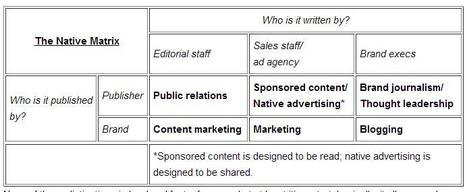Jay Rosen asks, reasonably, that people start drawing useful distinctions between buzzy terms like content marketing, sponsored content, native advertising, and even brand journalism. Here’s my stab at it:
The Native Matrix
- Who is it written by? Editorial staff, Sales staff, ad agency, Brand execs
- Who is it published by? Publisher: Public relations, Sponsored content/
Native advertising, Brand journalism/Thought leadership or Brand: Content marketing, Marketing, Blogging
*Sponsored content is designed to be read; native advertising is designed to be shared.
None of these distinctions is hard and fast, of course, but at least it’s a start; basically, it all comes down to who writes the content in question....



 Your new post is loading...
Your new post is loading...












Very interesting effort to define "native" advertising, content marketing, brand journalism and sponsored content.